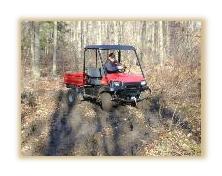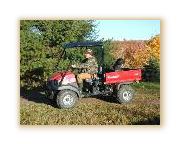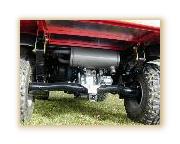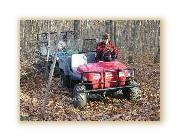2002 Multi Seat Cargo Unit Shootout
Multi-Seat Cargo Unit
Shoot-Out.
| Big Utility Machine Shoot-Out. (MSCU) Multi-Seat-Cargo-Units. |
 |
 heavy duty workhorses are the largest players. The last of the true utility machines, these multipurpose Machines can weigh as much as 1,400 lbs. The side-by-side seating of these units definitely adds to the riding experience as there’s nothing like two riders sharing and enjoying the trail together. Anyone who shows an interest in the large multi-seating utility machines either has a strong interest in work or an adventurer’s spirit for fun. The biggest factor in purchasing multi-seated units would have to be price; these units are priced substantially higher than your typical big bore ATV. However, the consolation prize to this vehicle other than outworking the typical ATV is that it can also haul two people eliminating the need for two machines. In the long run, these heavy duty units could save a lot of money. The uses for a multi-seated cargo box unit are limitless. Some users may have purchased the unit to keep up around the yard. Others may use the unit to maintain hunting stands or move feed out to their livestock. One of the greatest uses that we have found for the multi-seated units is the mobility it provides for older people who have lost the ability to walk their own property. Older hunters, who can’t make the walk to their favorite hunting spot, can again feel the freedom of making the hunt. The multi-seated cargo box units may cost a little more but the freedom and work that can be obtained is well worth the price.
heavy duty workhorses are the largest players. The last of the true utility machines, these multipurpose Machines can weigh as much as 1,400 lbs. The side-by-side seating of these units definitely adds to the riding experience as there’s nothing like two riders sharing and enjoying the trail together. Anyone who shows an interest in the large multi-seating utility machines either has a strong interest in work or an adventurer’s spirit for fun. The biggest factor in purchasing multi-seated units would have to be price; these units are priced substantially higher than your typical big bore ATV. However, the consolation prize to this vehicle other than outworking the typical ATV is that it can also haul two people eliminating the need for two machines. In the long run, these heavy duty units could save a lot of money. The uses for a multi-seated cargo box unit are limitless. Some users may have purchased the unit to keep up around the yard. Others may use the unit to maintain hunting stands or move feed out to their livestock. One of the greatest uses that we have found for the multi-seated units is the mobility it provides for older people who have lost the ability to walk their own property. Older hunters, who can’t make the walk to their favorite hunting spot, can again feel the freedom of making the hunt. The multi-seated cargo box units may cost a little more but the freedom and work that can be obtained is well worth the price.
Testing the Units
Our test included the Kawasaki Mule, Polaris Ranger and The Toro Twister. We started off with lining up the units and walking around them looking for apparent likes and dislikes. The most apparent differences were in body structure and overall stance, suspension and ergonomics. All units were tested in the same way, using several different test riders. Each machine is portrayed differently in the mind of each rider giving way to several opinions. As with any shoot-out, each of the machines is put through the exact same tests. One point that must be made in this test is that both the Ranger and the Mule are four-wheel drive units, the Twister is not. Some may ask, “Why include the Twister?” The reason for this is that we intended to test the top manufacturers’ Multi-Seat Cargo Units. The Twister may not be Four-Wheel Drive but it has a large swiveling joint in the middle of the unit allowing the unit to keep all four wheels on the ground no matter what the off camber situation making for a two-wheel drive unit with superior traction. We just had to see how this compared to a Four Wheel Drive unit.
several opinions. As with any shoot-out, each of the machines is put through the exact same tests. One point that must be made in this test is that both the Ranger and the Mule are four-wheel drive units, the Twister is not. Some may ask, “Why include the Twister?” The reason for this is that we intended to test the top manufacturers’ Multi-Seat Cargo Units. The Twister may not be Four-Wheel Drive but it has a large swiveling joint in the middle of the unit allowing the unit to keep all four wheels on the ground no matter what the off camber situation making for a two-wheel drive unit with superior traction. We just had to see how this compared to a Four Wheel Drive unit.
Engine/Transmission/Suspension
The typical reason for owning one of these MSC units (multi-seat-cargo units) is work; and the more functional the unit is, the better it can perform. Let’s lay out some of the basic specifications of each unit, starting with the mule. We tested the Mule 3010, which is well suited for work, powered by a 617cc. Liquid cooled four-stroke V-twin engine. The very responsive engine uses a 76x 68mm bore and stroke with fuel being supplied by a Mikuni BW26-18carburetor. We like the placement of the engine, center of gravity was low and all the basic maintenance items were easily accessible. The Mule was not the fastest of the three, but was fast enough to travel long distances with ease. The Mule did seem to be governed to a point; this makes us wonder if the unit could have had more power and speed available. Putting the power to the wheels is a CVT transmission (continuously variable transmission). The transition between raw power and usable acceleration was flawless, a wide ratio of pulling power and quick responsive speed changes were impressive. The unit is equipped with in-and-out 4-wheel drive and a dual range transfer case gives the operator the option of a lower gear ratio for extra workable power. The
Mule 3010, which is well suited for work, powered by a 617cc. Liquid cooled four-stroke V-twin engine. The very responsive engine uses a 76x 68mm bore and stroke with fuel being supplied by a Mikuni BW26-18carburetor. We like the placement of the engine, center of gravity was low and all the basic maintenance items were easily accessible. The Mule was not the fastest of the three, but was fast enough to travel long distances with ease. The Mule did seem to be governed to a point; this makes us wonder if the unit could have had more power and speed available. Putting the power to the wheels is a CVT transmission (continuously variable transmission). The transition between raw power and usable acceleration was flawless, a wide ratio of pulling power and quick responsive speed changes were impressive. The unit is equipped with in-and-out 4-wheel drive and a dual range transfer case gives the operator the option of a lower gear ratio for extra workable power. The drive train also features a dual-mode rear differential providing easy steering and a rear-locking differential when needed, we also wanted to mention an 11.2-foot turning radius. The overall ride of the mule is a bit stiff, but we understand and like the stiff front springs and the impressive rear leaf spring set-up. When a suspension is set up right with the proper power and traction configuration, a “Just Right” combination is produced. Load the Mule’s cargo box and the ride improves. Under body protection was sparse, although the mule never left us hung-up. We liked the mule’s power and 4-wheel drive options, not much to complain about this unit. Look to create a combination of work and play while using the Mule.
drive train also features a dual-mode rear differential providing easy steering and a rear-locking differential when needed, we also wanted to mention an 11.2-foot turning radius. The overall ride of the mule is a bit stiff, but we understand and like the stiff front springs and the impressive rear leaf spring set-up. When a suspension is set up right with the proper power and traction configuration, a “Just Right” combination is produced. Load the Mule’s cargo box and the ride improves. Under body protection was sparse, although the mule never left us hung-up. We liked the mule’s power and 4-wheel drive options, not much to complain about this unit. Look to create a combination of work and play while using the Mule.
 produces excellent power and acceleration. The Ranger is probably the easiest to enter and exit from; the interior foot area is large with slide through access. The Ranger also seats three, a definite plus! Engine placement is just under the driver making for a perfectly balanced machine and a low center of gravity. We also noticed plenty of plastic protection surrounding the engine compartment, helping to keep mud and debris out of the engine area. A CVT automatic transmission, with hi/low and reverse, powers the MSC unit. Don’t worry about burdening the belt with large loads, a redesigned more durable belt produces plenty of trouble free pulling power. Traction was superior, with an in-and out 4-wheel drive and a differential lock. A full chassis plastic skid plate lined the underbelly; this and the intimidating ground clearance will take the Ranger anywhere. McPherson struts suspend the front and dual spring over shocks give the rear an excellent ride. Even with a large load in the cargo box, the suspension was smooth. Just remember that with large loads turn up the adjustable rear shocks for a better ride. In this category, the Ranger was increasingly positive.
produces excellent power and acceleration. The Ranger is probably the easiest to enter and exit from; the interior foot area is large with slide through access. The Ranger also seats three, a definite plus! Engine placement is just under the driver making for a perfectly balanced machine and a low center of gravity. We also noticed plenty of plastic protection surrounding the engine compartment, helping to keep mud and debris out of the engine area. A CVT automatic transmission, with hi/low and reverse, powers the MSC unit. Don’t worry about burdening the belt with large loads, a redesigned more durable belt produces plenty of trouble free pulling power. Traction was superior, with an in-and out 4-wheel drive and a differential lock. A full chassis plastic skid plate lined the underbelly; this and the intimidating ground clearance will take the Ranger anywhere. McPherson struts suspend the front and dual spring over shocks give the rear an excellent ride. Even with a large load in the cargo box, the suspension was smooth. Just remember that with large loads turn up the adjustable rear shocks for a better ride. In this category, the Ranger was increasingly positive.
Now for the quietest of the units, the Toro Twister that is powered by a 480cc. Briggs & Stratton V-twin Vanguard, air-cooled engine. Smooth, quiet and fun to drive truly describes the Twister. The Twister is equipped with a CV Transmission. Although the machine accelerates smoothly, we did not like the open belt on the CV Transmission. The engine and the CVT are located in the lower rear portion of the unit; this produces a low center of gravity and plenty of traction but allows the belt to be submersed in any large water holes. An enclosed belt housing would do wonders for dependability. We have to remember the Toro unit is really not in the same class, being it is only a 2-wheel drive unit. On long distance runs, the Toro was the slowest. Yes, slow; but this unit always managed to go where the other units did tread. The front suspension consisted of two spring over shocks and the rear depended on the Active-In-Frame suspension, which is a swivel joint in the middle of the unit. The AIF suspension allows the entire vehicle frame to literally twist, responding to any terrain and producing excellent traction. The MSC unit was a workhorse, handling heavy loads and working around the farm with out excuses. This unit excelled in several categories; the first was smooth and quite operation. Next, the overall turning radius was far superior to the others, the Twister could turn the front wheels to near a 90° angle, producing a 9-foot turning radius. The Twister hangs tough with the 4×4 units.
center of gravity and plenty of traction but allows the belt to be submersed in any large water holes. An enclosed belt housing would do wonders for dependability. We have to remember the Toro unit is really not in the same class, being it is only a 2-wheel drive unit. On long distance runs, the Toro was the slowest. Yes, slow; but this unit always managed to go where the other units did tread. The front suspension consisted of two spring over shocks and the rear depended on the Active-In-Frame suspension, which is a swivel joint in the middle of the unit. The AIF suspension allows the entire vehicle frame to literally twist, responding to any terrain and producing excellent traction. The MSC unit was a workhorse, handling heavy loads and working around the farm with out excuses. This unit excelled in several categories; the first was smooth and quite operation. Next, the overall turning radius was far superior to the others, the Twister could turn the front wheels to near a 90° angle, producing a 9-foot turning radius. The Twister hangs tough with the 4×4 units.
